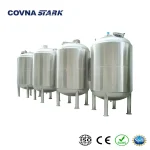Choosing the right water tank size is the most critical decision you will make in your water storage project. Go too small, and you risk production shutdowns. Go too big, and you have tied up capital in a tank you will never fully use.
As manufacturers of industrial water tanks for the US and global markets, one of the first questions our clients ask is: “What size water tank do I actually need?”
The answer is not just about capacity in gallons. It is equally about water storage tank dimensions – the physical footprint and height. This guide walks you through our expert process for specifying the right tank capacity and dimensions for your project.

Why Getting the Size Right Matters (The Cost of “Guessing”)
Before we dive into calculations, it is important to understand the risks of guessing your tank size. This is where many projects go wrong and where the cost of a mistake can be very high.
Risk 1: Undersizing (Catastrophic)
An undersized water storage tank can cause:
- Production shutdowns when cooling water, process water, or wash-down supply is exhausted.
- Inadequate fire protection if the tank does not meet NFPA-based fire water storage requirements in your jurisdiction.
- Low pressure and customer complaints in commercial buildings such as hotels or apartment blocks.
- Regulatory non-compliance and failed inspections from local authorities or insurers.
Risk 2: Oversizing (Expensive and Sometimes Unsafe)
Oversizing sounds safe, but it can hurt your project in other ways:
- Higher capital cost for steel, foundations, transport, and installation.
- Increased structural demands on your slab or building due to additional weight.
- Water quality issues when stored water remains stagnant and disinfectant residuals drop over time.
- Needless footprint that consumes valuable space on roofs, in mechanical rooms, or in yards.
Getting the size right is ultimately about balancing operational security, regulatory compliance, and total lifecycle cost.
Capacity (Gallons) vs. Dimensions (Feet): What’s the Difference?
When engineers talk about water tank sizing, there are two different questions you must answer:
Water Storage Tank Sizes (Capacity)
This is the usable volume of the tank, typically measured in gallons in the US or liters elsewhere. Capacity is driven by:
- Peak daily water usage (industrial, commercial, or residential)
- Number of reserve days you need if supply is interrupted
- Fire flow and duration required by your local fire code or NFPA-based standards
Water Storage Tank Dimensions (Footprint and Height)
Dimensions describe the physical size of the tank:
- Diameter or width for vertical cylindrical or rectangular tanks
- Length for horizontal tanks
- Overall height, including manways and nozzles
A 50,000-gallon tank that looks perfect on paper is useless if its diameter does not fit your site, or if its height is greater than your ceiling or zoning limit.
That is why you must solve for both capacity and dimensions at the same time.
How to Calculate Your Required Water Storage Capacity (Gallons)
Here is the simple, practical framework we use with our industrial clients. The goal is to calculate a minimum required storage volume that supports operations, emergencies, and fire protection.
Step 1: Determine Your Peak Daily Usage
Start with the busiest day of the year. For industrial plants, this might include:
- Cooling tower make-up water
- Process water and CIP cycles
- Wash-down and sanitation flows
- Any irrigation or utility water uses on-site
For commercial buildings, consider:
- Guest occupancy (hotels, resorts)
- Number of apartments or offices
- Peak usage times (morning showers, evening usage)
Express this as a single number: Peak Daily Usage (gallons/day).
Step 2: Add Your Emergency Reserve (Days of Storage)
Next, decide how many days of water you need to ride out a supply interruption. For industrial applications, we often recommend 2–3 days of storage, depending on how critical water is to your operations.
Basic reserve volume:
Reserve Volume (gallons) = Peak Daily Usage × Reserve DaysStep 3: Add Fire Suppression Needs
If your tank will also support fire suppression, this is usually a non-negotiable number set by local building codes, the fire marshal, or NFPA-based standards.
Typical fire sizing is based on:
- Required fire flow (gallons per minute)
- Required duration (minutes)
- The type of sprinkler or hydrant system being supplied
Fire volume is computed as:
Fire Volume (gallons) = Fire Flow (gpm) × Duration (minutes)Putting It All Together: Simple Sizing Formula
A practical first-pass formula for total storage is:
Total Required Capacity
= (Peak Daily Usage × Reserve Days)
+ Fire Suppression Volume
In a detailed design, engineers may refine this number with hourly demand profiles, redundancy, and additional safety factors—but this simple equation is an excellent starting point for water tank sizing.
Capacity Sizing Examples (Industrial & Commercial)
Example 1: Industrial Process Water
A medium-size factory uses 12,000 gallons per day at peak, including cooling tower make-up and wash-down. The plant requires two days of storage and has a separate fire water system.
Peak Daily Usage = 12,000 gallons
Reserve Days = 2
Fire Volume = 0 (separate fire tank)
Total Capacity = 12,000 × 2 = 24,000 gallonsExample 2: Commercial Building (Hotel)
A hotel has a peak daily demand of 8,000 gallons and wants one day of storage. Local fire code requires a 30,000-gallon reserve for sprinklers and hydrants.
Peak Daily Usage = 8,000 gallons
Reserve Days = 1
Fire Volume = 30,000 gallons
Total Capacity = (8,000 × 1) + 30,000
= 38,000 gallonsExample 3: Fire Suppression Only
For a dedicated fire water tank, capacity is often driven entirely by fire flow and duration specified in NFPA 22, NFPA 13, or local codes. For example, a code might require a minimum of 50,000 gallons for a specific occupancy type. Your engineer or fire protection consultant will confirm this requirement.
Understanding Standard Industrial Water Tank Sizes (Chart)
To directly answer the “water storage tank sizes” question, here is a simplified chart with typical vertical stainless steel tank sizes. Exact dimensions vary by manufacturer and design pressure, but this table provides a helpful starting point.
| Nominal Capacity (Gallons) | Typical Use Case | Typical Diameter (Feet) | Typical Height (Feet) |
|---|---|---|---|
| 5,000 Gallons | Small business, large farm, light commercial | ~8' | ~13.5' |
| 10,000 Gallons | Small factory, commercial building, hotel | ~10' | ~17.5' |
| 20,000 Gallons | Medium factory, process water buffer | ~12' | ~24' |
| 50,000 Gallons | Large plant, combined domestic + fire reserve | ~20' | ~22' |
| 100,000+ Gallons | Municipal, large industrial campus, central fire tank | Custom | Custom |
Disclaimer: These dimensions are estimates for illustration only. Always refer to manufacturer drawings and engineering calculations for exact tank dimensions and structural loads.
If you would like to see how actual standard tank models compare, you can also review published size tables from other manufacturers as a reference point.
Don’t Forget Dimensions! (Planning for Installation)
Once you have a target capacity, you still need to confirm that the tank’s dimensions are compatible with your site and installation plan. This is where our experience as a manufacturer is especially valuable.
Ceiling Height and Structural Clearance
If your water tank is going indoors—on a mezzanine, in a mechanical room, or in a basement— you must check:
- Clear structural height from finished floor to lowest beam or duct.
- Height of the tank shell plus top nozzles, manways, and insulation.
- Space for access platforms and safety railings as required.
A 24-foot tall tank simply will not fit in a 20-foot room, and cutting a roof opening later is far more expensive than sizing correctly at the beginning.
Footprint, Foundations, and Access
Consider the tank’s diameter or width versus:
- Available space on your concrete pad or structural steel frame.
- Setbacks from walls, columns, and other equipment.
- Room for future maintenance, insulation, and piping changes.
Tanks over certain capacities may require a dedicated reinforced foundation or deeper footings.
Delivery Route and Erection Method
Finally, think about how the tank will get into the building or yard:
- Can a fully-welded tank be delivered by truck and lifted into place by crane?
- Do site access roads, gates, and doorways limit the maximum diameter or height of shipped components?
- Would a bolted stainless steel tank or panel type tank assembled on-site be more practical?
These are exactly the kinds of constraints our engineering team reviews when we design a tank for your project.
The Stark Water Solution: Custom Tanks for Any Dimension
When standard water storage tank sizes do not fit your site, a custom design is often the most efficient solution. Many industrial clients operate in tight mechanical rooms, rooftop spaces, or narrow utility corridors where “catalog” sizes simply do not work.
- Need a 15,000-gallon tank but only have 12 feet of height? We can design a wider, shorter tank that still meets your capacity and code requirements.
- Need to fit a tank in a long, narrow corridor? We can build a rectangular or horizontal stainless steel tank to match that footprint.
- Need separate compartments for process water and fire reserve? We can design a multi-chamber tank with internal baffles and dedicated outlets.
This is where our expertise as a stainless steel tank manufacturer shines. We build tanks to fit your exact dimensions, capacity needs, material selection, and industry standards.
You can explore some of our core product lines here:
- Standard stainless steel water tanks for vertical and horizontal storage.
- Customized stainless steel tanks engineered to your specific volume, shell diameter, and height.
- Insulated stainless steel tanks when thermal performance and temperature control are critical.
Conclusion: Stop Guessing. Get an Expert Specification.
Choosing the right water tank size is a foundational engineering decision. It affects your production uptime, fire protection strategy, water quality, and long-term operating cost.
Instead of guessing, follow a structured process:
- Quantify your peak daily usage.
- Decide how many days of reserve you truly need.
- Add any required fire suppression volume.
- Verify that the resulting tank dimensions actually fit your site.
The team at Stark Water has decades of experience helping industrial and commercial clients specify and build the right stainless steel water tank for their projects.
If you would like a professional sizing review, we invite you to:
- Contact us today for a free sizing consultation with our engineering team.
- Explore our industrial stainless steel tanks to see standard and custom-ready configurations.
About the Author: The Stark Water Team
This guide is based on decades of combined experience from the engineering team at Stark Environmental Solutions Ltd, the company behind Stark stainless steel water tanks .
As a leading authority in stainless steel fabrication and water treatment equipment, we design and manufacture mechanical filters, insulated tanks, sterile water tanks, pressure tanks, and customized stainless steel water storage solutions used across electronics, pharmaceuticals, power plants, food & beverage, and more.
Our goal is to provide trustworthy, technically accurate guidance so that facility owners, engineers, and contractors can make informed decisions about critical water storage infrastructure. If you have a project in mind, you can contact our team for detailed drawings, quotations, and sizing support.









